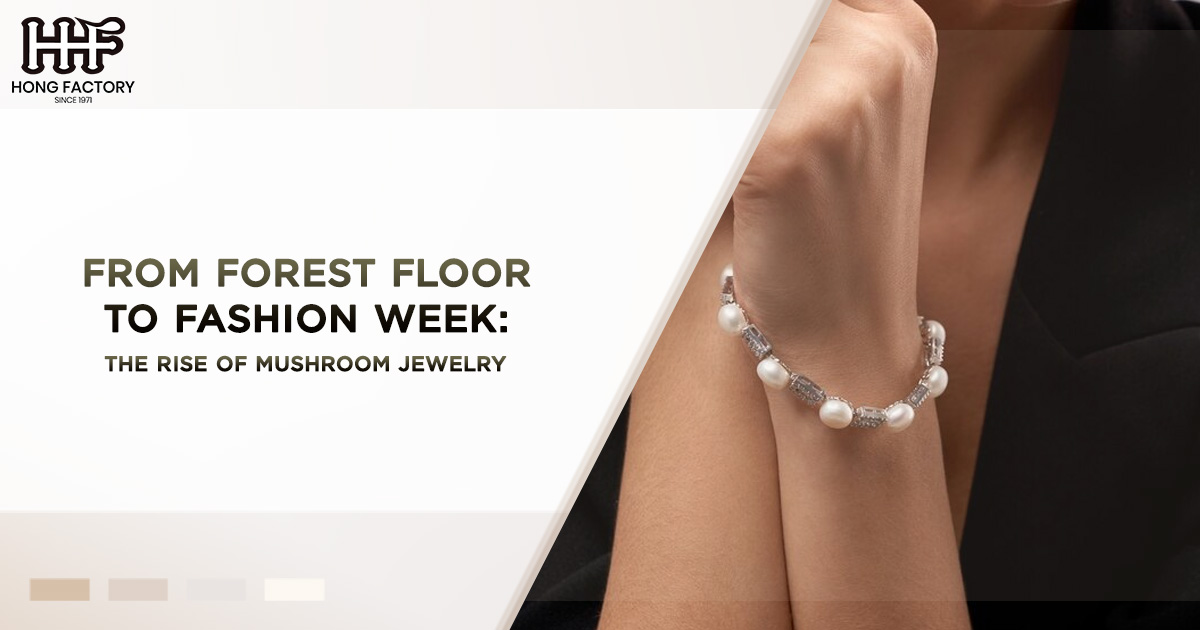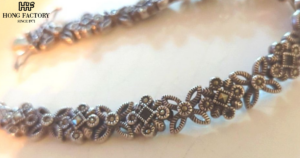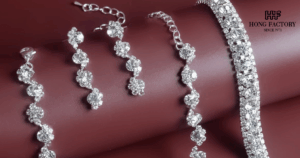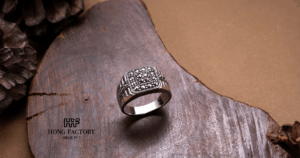In recent years, the intersection of nature, sustainability, and fashion has given rise to a fascinating trend: mushroom-inspired jewelry. With its undeniable charm, eco-friendly ethos, and innovative use of materials, mushroom jewelry has captured the imagination of designers and consumers alike. From delicate fungal-inspired motifs to cutting-edge biomaterials, this new wave of jewelry design reflects a deeper connection to the natural world and a commitment to sustainable living.
Explore how mushrooms and fungi inspire jewelry design, and discover why this unique trend is making waves in the worlds of art, fashion, and sustainability.
The Fascination with Mushrooms – Fungal Inspiration in Art and Design
Mushrooms have long been a source of fascination for scientists, artists, and nature enthusiasts. Their mysterious growth patterns, intricate structures, and vital role in ecosystems make them a compelling subject for creative expression. In the world of jewelry, mushrooms provide endless design opportunities, from their organic shapes and textures to their symbolic meanings.
Mushrooms as a Symbol of Nature and Renewal
Fungi are often associated with life cycles, regeneration, and interconnectedness. In forests, mushrooms play a crucial ecological role as decomposers, breaking down organic matter and recycling nutrients back into the soil. This symbolism resonates deeply in a world increasingly focused on sustainability and environmental stewardship.
Jewelry designers are tapping into this symbolism, using mushrooms as a metaphor for renewal, resilience, and the beauty of life’s natural processes. As a result, fungal inspiration has become a powerful narrative in eco-design.
The Aesthetic Appeal of Mushrooms
Mushrooms possess a unique aesthetic that blends elegance and whimsy. Their organic forms—ranging from delicate caps to textured gills—translate beautifully into jewelry design. Whether sculpted into pendants, earrings, or rings, mushroom-inspired jewelry often features intricate details that mimic nature’s artistry.
Designers take cues from the diverse shapes and colors of fungi, from the earthy tones of chanterelles to the vibrant hues of fly agarics. These designs not only celebrate the beauty of mushrooms but also evoke feelings of wonder and connection to the natural world.
Sustainable Materials – Mushrooms as Biomaterials in Jewelry
One of the most exciting developments in mushroom-inspired jewelry is the use of fungi themselves as sustainable materials. As the fashion industry grapples with its environmental impact, biomaterials derived from mushrooms offer a revolutionary approach to eco-friendly design.
Mycelium: Nature’s Versatile Material
At the heart of this innovation is mycelium, the root-like structure of fungi. Mycelium is a renewable, biodegradable material with remarkable versatility. It can be grown into various shapes and textures, making it an ideal medium for jewelry design.
Several designers and startups are experimenting with mycelium to create lightweight, durable, and sustainable jewelry pieces. Unlike traditional materials such as gold or plastic, mycelium production has a minimal environmental footprint. It requires little water, no toxic chemicals, and can be grown using agricultural waste, making it a truly circular material.
Combining Mycelium with Traditional Elements
To enhance durability and aesthetic appeal, mycelium is often combined with other eco-friendly materials, such as recycled metals or natural dyes. This fusion of traditional craftsmanship and cutting-edge biomaterials results in jewelry that is both innovative and timeless.
For example, a pendant made from mycelium might be set in a frame of recycled silver, creating a striking contrast between organic and metallic elements. These designs not only showcase the potential of biomaterials but also highlight the importance of sustainability in modern jewelry.
The Role of Eco-Design: Creating Jewelry with a Purpose
As consumers become more conscious of their purchasing decisions, eco-design has emerged as a defining principle in jewelry creation. Mushroom-inspired jewelry embodies the values of eco-design, blending artistry with sustainability to create pieces that are as meaningful as they are beautiful.
Reducing Waste and Carbon Footprints
Eco-design prioritizes responsible sourcing and production methods to minimize environmental impact. By using sustainable materials like mycelium, reclaimed wood, or recycled metals, mushroom-inspired jewelry reduces waste and carbon footprints.
Many designers also adopt slow fashion principles, creating small-batch collections or made-to-order pieces to avoid overproduction. This approach not only reduces waste but also allows for greater attention to detail and craftsmanship.
Supporting Local and Ethical Practices
Eco-design extends beyond materials to include ethical practices. Many mushroom jewelry brands collaborate with local artisans and communities, supporting traditional skills and fair labor practices. By fostering these partnerships, they contribute to social sustainability as well as environmental goals.
The Intersection of Nature and Technology – Innovation in Mushroom Jewelry
The rise of mushroom jewelry reflects a broader trend of blending nature and technology in fashion. Advances in biomaterials and 3D printing have opened up new possibilities for designers, allowing them to push the boundaries of creativity and sustainability.
3D Printing with Mycelium
3D printing has revolutionized the way jewelry is made, enabling precise designs and reduced material waste. When combined with mycelium, this technology allows for intricate, nature-inspired pieces that would be nearly impossible to create by hand.
For example, a designer might use 3D printing to replicate the delicate gills of a mushroom, creating a pendant that mimics the complexity of fungi in the wild. The result is a piece of jewelry that is both futuristic and deeply rooted in nature.
Bio-Textiles and Hybrid Designs
In addition to mycelium, other fungi-derived materials, such as fungal leather, are being incorporated into jewelry design. These bio-textiles offer a sustainable alternative to conventional materials while maintaining durability and aesthetic appeal.
Hybrid designs that combine fungal materials with traditional elements are gaining popularity, showcasing the potential of biomaterials to transform the fashion industry. These innovations not only expand the creative possibilities for designers but also challenge consumers to rethink their relationship with materials and sustainability.
Why Mushroom Jewelry Is a Growing Trend
Mushroom jewelry resonates with a wide audience, from eco-conscious consumers to fashion-forward trendsetters. Several factors contribute to its growing popularity:
A Celebration of Nature
In an increasingly urbanized world, mushroom jewelry offers a way to reconnect with nature. Its organic forms and earthy materials evoke a sense of grounding and harmony, appealing to those who value the natural world.
Sustainability as a Lifestyle
As sustainability becomes a global priority, mushroom jewelry aligns with the values of conscious living. By choosing pieces made from eco-friendly materials, consumers can express their commitment to protecting the planet.
Unique and Conversation-Worthy
Mushroom jewelry stands out for its uniqueness and creativity. Whether it’s a pendant shaped like a toadstool or earrings made from mycelium, these pieces are sure to spark conversations and inspire curiosity.
Bridging Art and Science
The use of biomaterials in jewelry design highlights the intersection of art and science. Mushroom jewelry celebrates the beauty of fungi while showcasing the potential of innovative materials to reshape the fashion industry.
Iconic Designs and Designers – Leaders in the Mushroom Jewelry Movement
Several designers and brands are leading the charge in mushroom-inspired jewelry, using their creations to raise awareness about sustainability and the wonders of fungi.
Nature-Inspired Studios
Independent artisans and small studios often draw inspiration directly from nature, creating one-of-a-kind pieces that capture the essence of mushrooms. These designs range from minimalist to intricate, reflecting the diversity of fungi in the natural world.
Biomaterial Innovators
Startups specializing in biomaterials are pushing the boundaries of what’s possible with mycelium and other fungal materials. Their work not only redefines jewelry design but also paves the way for broader applications of sustainable materials in fashion and beyond.
The Future of Mushroom Jewelry – A Sustainable Fashion Statement
As the mushroom jewelry trend continues to grow, it’s clear that this is more than a passing fad. By combining fungal inspiration with sustainable materials and innovative design techniques, this movement represents a shift toward a more thoughtful and eco-friendly approach to fashion.
Looking ahead, we can expect to see even more experimentation with biomaterials, as well as greater collaboration between designers, scientists, and environmentalists. Mushroom jewelry is not just a celebration of nature—it’s a call to action for a more sustainable future.
Conclusion
From the forest floor to fashion week, mushroom jewelry is transforming the way we think about design, materials, and sustainability. By drawing inspiration from fungi, designers are creating pieces that are as beautiful as they are meaningful.
Whether you’re a nature lover, an eco-conscious shopper, or a trend enthusiast, mushroom jewelry offers a unique way to connect with the natural world and embrace the principles of sustainable living. As this movement continues to grow, one thing is clear: the future of jewelry is rooted in the earth.




